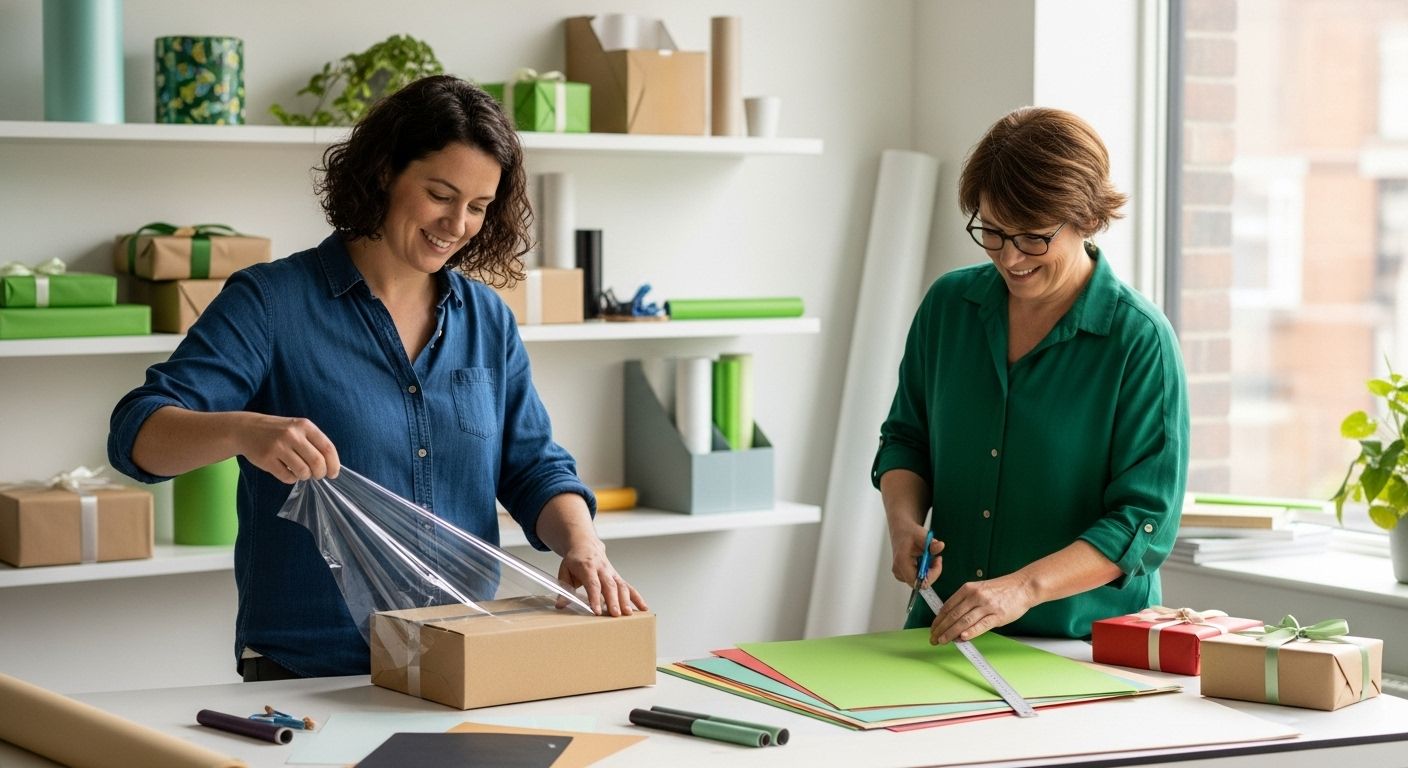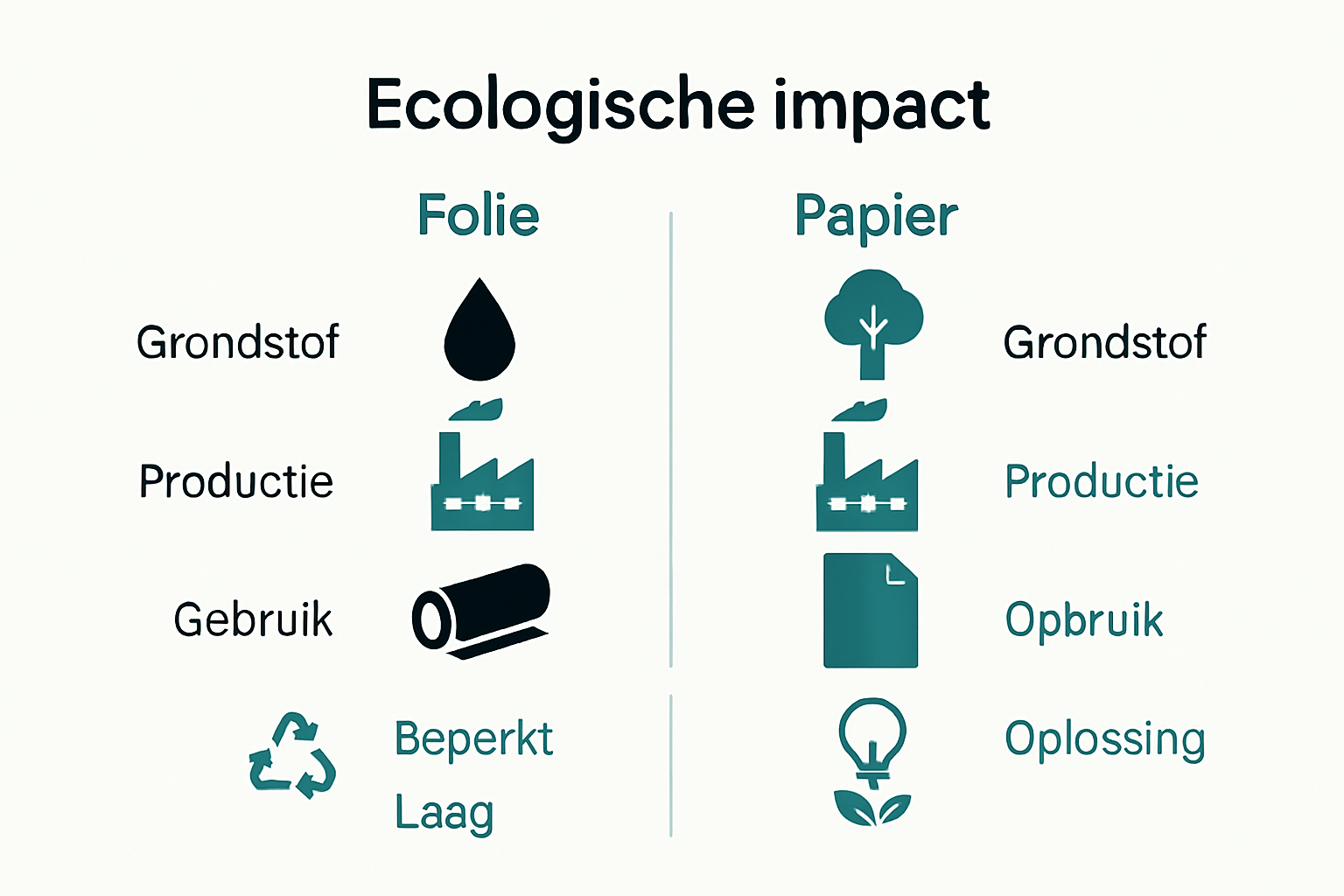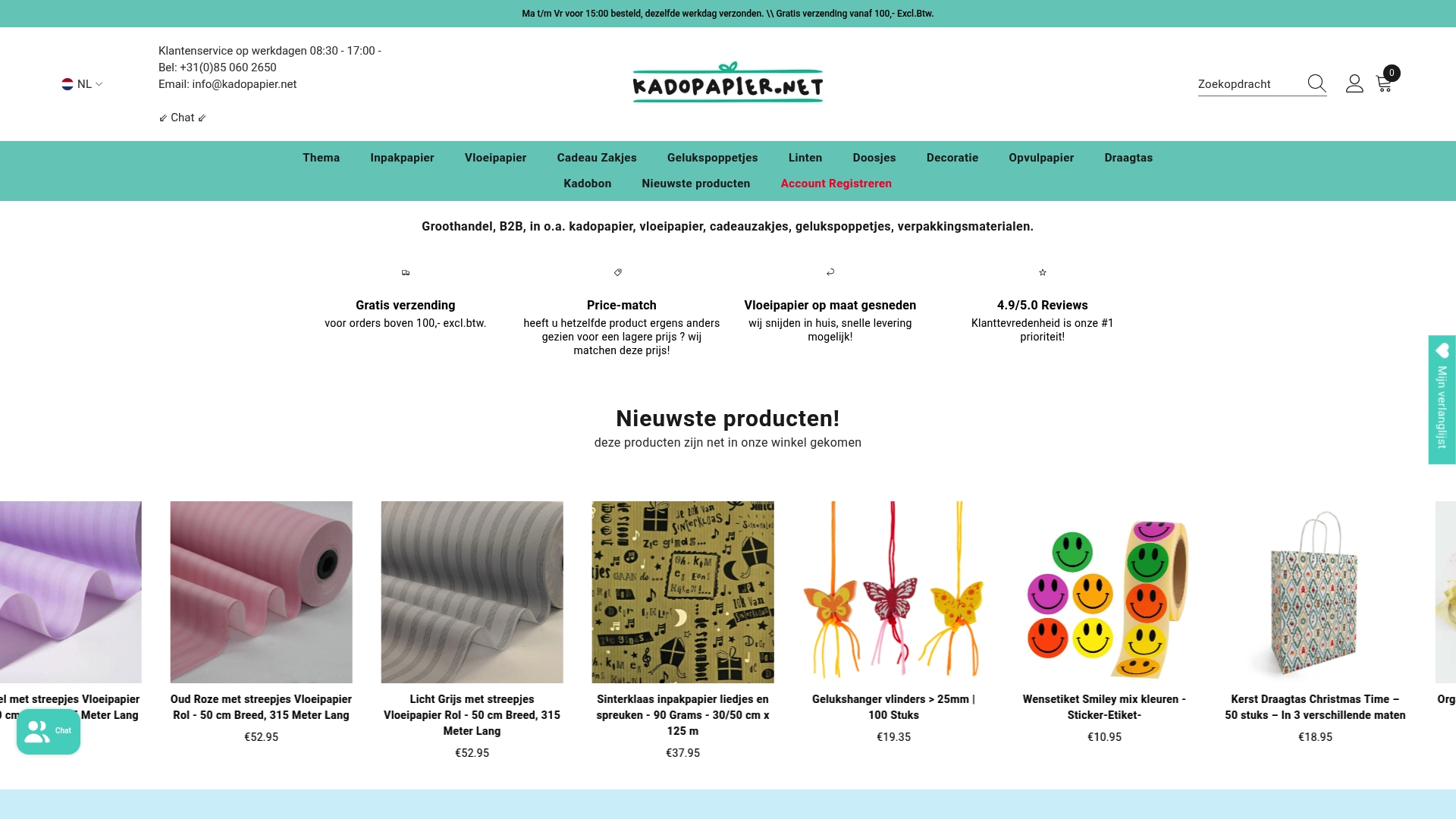Using Foil or Paper: Understand the Basics and Applications
Foil and paper seem like common materials, found everywhere in packaging, shops, and even in home crafts. Surprisingly, the global paper industry alone produces over 400 million tons annually , which is enormous considering how light a sheet of paper feels. But what you might not expect is that both materials are created through completely different processes, and their impact on the environment and daily life is far greater than the naked eye suggests.

Table of contents
- What is foil or paper and how is it made?
- Why is it important to use foil or paper?
- How does foil or paper work in different applications?
- What are the different types of foil and paper?
- How do environmental issues affect the use of film and paper?
Short Summary
| Take the message | Explanation |
|---|---|
| Paper is mainly made of wood fibers | Paper is made by processing and drying wood into a thin layer. This process is essential for the quality and durability of the paper. |
| Foil is a synthetic material | Film is made from plastics such as polyethylene and offers versatility in applications such as packaging and industrial products. |
| Both materials offer protection | Foil and paper protect products from contamination, damage and spoilage, extending their shelf life. |
| Sustainability is crucial for the future | The production of foil and paper must become more environmentally friendly, with an emphasis on recycled and biodegradable materials. |
| Versatility in applications is key | Foils and paper are used in diverse sectors, from food packaging to technical and medical applications, with unique properties that make them effective. |
What is foil or paper and how is it made?
Foil and paper are two fundamental materials with countless applications in our daily lives, from packaging to crafts. Both materials are produced through complex processes that transform raw materials into useful products with unique properties.
Paper: A Traditional Material with a Rich History
Paper is a fibrous material made primarily from wood fibers, produced by chopping wood and processing it into a thin sheet. Scientific studies show that the papermaking process involves several crucial steps:
- Logging and selection of suitable tree species
- Processing of wood into wood fibers
- Mixing fibers with water to create pulp
- Drain and dry the pulp into a uniform layer
Modern papermaking has developed advanced techniques to improve quality and sustainability, particularly by using recycled materials and implementing environmentally friendly production processes.
Foil: Synthetic Material with Versatile Properties
Film, on the other hand, is a thin, flexible layer made of plastics such as polyethylene or polypropylene. Scientific research reveals that film production is a complex process requiring polymer extrusion and precision technology:
- Selection of suitable polymer raw material
- Melting and deforming of polymers
- Extracting and cooling the material
- Treat for specific properties such as transparency or strength
Foil is widely used in packaging, agriculture, medical applications and industrial sectors because of its lightweight and protective properties.
Both materials play a crucial role in modern societies, each with its own unique characteristics and applications. Whether for gift wrapping or technical applications, foil and paper remain indispensable materials in numerous industries.
Why is it important to use foil or paper?
Film and paper are not just everyday materials, but essential solutions that combine protection, functionality, and aesthetics in numerous applications. Their importance extends far beyond simple packaging to crucial protective and presentation purposes.
Protection and Conservation
A primary function of film and paper is to provide protection for products. Research from the Hong Kong Centre for Food Safety emphasizes that these materials are critical for preventing contamination, physical damage, and spoilage from exposure to external factors.
Protective features include:
- Insulation against moisture and pollution
- Protection against mechanical damage
- Maintaining product quality
- Extension of shelf life
Versatile Application Possibilities
Foil and paper are distinguished by their enormous versatility. They are used in sectors ranging from food packaging to technical industries. Read more about creative applications of tissue paper to discover the limitless possibilities.
Areas of application include:
- Food packaging and preservation
- Industrial and technical protection
- Decorative and presentation purposes
- Medical and pharmaceutical sector
These materials not only fulfill practical functions but also contribute to aesthetic presentation and brand identity. Whether it's a tightly wrapped gift or a precision technical part, foil and paper are indispensable components in modern production and presentation processes.
Their importance cannot be underestimated: they protect, preserve, present, and communicate simultaneously. In a world that revolves around quality, safety, and visual appeal, film and paper remain fundamental materials that shape our daily experiences.
How does foil or paper work in different applications?
Film and paper are exceptionally versatile materials that adapt their performance to the specific requirements of different industries and applications. Their functional properties make them indispensable in countless sectors.
Food and Packaging Industry
Research into packaging materials shows that aluminum foil and paper perform crucial protective functions. They create a complete barrier against external influences such as light, moisture, and oxygen, allowing products to be stored longer.
In the food sector, these materials function by:
- Hygienic sealing of products
- Protection against bacterial contamination
- Preserving freshness and taste
- Extension of shelf life
Industrial and Technical Applications
Outside of the food sector, foil and paper serve numerous technical purposes. They are used for electrical insulation, precision packaging of sensitive components, and as protective interlayers in manufacturing processes.
Explore the creative possibilities of tissue paper to see how versatile this material can be. Some industrial applications include:
- Electrical insulation
- Protection of precision instruments
- Thermal regulation
- Sound insulation
Medical and Pharmaceutical Sector
In healthcare, film and paper are essential for sterile packaging, medication storage, and medical devices. They guarantee the protection, hygiene, and integrity of sensitive products.
Their functional properties make film and paper more than just ordinary materials. They are active protectors, communication tools, and essential components in modern production processes. From food preservation to high-tech manufacturing, these materials fulfill critical roles that support our daily lives and industrial systems.

What are the different types of foil and paper?
The world of film and paper is much richer and more diverse than most people realize. Each type has unique properties, production processes, and specific applications tailored to different industrial and creative needs.
Paper Types: A Spectrum of Possibilities
Scientific research into packaging materials shows that paper is a complex material with countless variations. The different types of paper are characterized by their composition, thickness, and treatment.
Main categories of paper include:
- Kraft paper: Strong and durable
- Glossy coated paper: Smooth and suitable for printing
- Newspaper: Light and cheap
- Archival paper: Acid-free and suitable for conservation
Foil Types: Technical Precision
Foil is distinguished by its thin, flexible structure and specific material properties. It is used in countless technical and industrial applications.
Explore creative uses for tissue paper to understand its versatility. Types of film include:
- Aluminum foil: Heat-resistant and lightproof
- Plastic film: Flexible and waterproof
- Metal foil: Conductive and protective
- Protective Film: Scratch-resistant for electronic devices
Specialized and Functional Variants
In addition to standard types, manufacturers are developing increasingly advanced film and paper variants. These are specifically designed for special applications such as medical packaging, electronic components, or environmentally friendly solutions.
Modern developments focus on sustainability, with reusable and biodegradable materials that retain the same protective properties. From food packaging to high-tech electronics, film and paper are essential components of our modern world.
The following table organizes the major categories and characteristics of both paper and foil types presented in the article, helping you quickly scan their unique features and applications.
| Type | Example/Variant | Key Properties | Typical Use |
|---|---|---|---|
| Paper | Kraft paper | Strong, durable | Packaging, wrapping |
| Paper | Glossy coated paper | Smooth, good for printing | Magazines, decorative wrapping |
| Paper | Newsprint | Lightweight, economical | Newspapers, packing filler |
| Paper | Archive paper | Acid-free, long-lasting | Archiving, art conservation |
| Foil | Aluminum foil | Heat-resistant, light-proof | Food packaging, cooking |
| Foil | Plastic film | Flexible, waterproof | Food wrap, industrial packaging |
| Foil | Metal foil | Conductive, shielding | Electronics, insulation |
| Foil | Protective film | Scratch-resistant | Electronics, screen protection |
How do environmental issues affect the use of film and paper?
Environmental issues are fundamentally transforming how we produce, use, and dispose of film and paper. Sustainability is no longer an option but a necessity that profoundly impacts our material choices.
Environmental Impact of Traditional Materials
Scientific research into polymers and packaging materials reveals the complex environmental challenges of film and paper. Traditional plastic film persists in the environment for centuries, while paper production has significant impacts on forestry.
Environmental challenges include:
- Long degradation time of plastics
- Deforestation due to paper production
- Pollution of ecosystems
- High energy consumption during manufacturing
Sustainable Innovations and Alternatives
Manufacturers and scientists are actively developing environmentally friendly solutions. Biodegradable materials, recycled raw materials, and renewable alternatives are rapidly gaining ground.
Discover creative uses for tissue paper and see how sustainability is shaping the future. Innovative approaches include:
- Biodegradable films
- Recycled paper fibers
- Plant-based polymers
- Reusable packaging materials
Consumer and Industrial Responsibility
The shift toward sustainability requires efforts from both consumers and industries. Conscious choices, effective recycling, and support for innovative materials are crucial.
Environmentally conscious strategies include:
- Reducing single-use materials
- Choosing recycled products
- Supporting local recycling initiatives
- Investing in reusable alternatives
The future of film and paper will be shaped by our collective efforts to minimize environmental impact. From product development to consumer behavior, we all play a role in creating a more sustainable world.

Discover the perfect solution for all your foil and paper needs
After reading this article, do you feel like finding the right foil or paper for your project is a challenge? Perhaps you're wondering which packaging material offers the best protection and appearance, or how to choose sustainably without compromising on quality. At Kadopapier.net , we understand these challenges. You'll find exactly the right paper or foil to meet your specific needs, from safe food packaging to creating an unforgettable gift.

Experience the convenience of a wide range of wrapping paper, tissue paper, and other packaging materials . In a single visit, you can choose from high-quality products suitable for both creative and professional applications. Don't wait any longer and visit Kadopapier.net today for the best foil and paper solutions. This way, you can make every packaging special.
Frequently Asked Questions
What are the main differences between foil and paper?
Foil is a thin, flexible layer of plastics such as polyethylene, while paper is a fibrous material made primarily from wood fibers. Foil is often used for packaging and protection, while paper has a variety of applications, from printing to crafts.
How is paper produced?
Paper is made by reducing wood to wood fibers, which are then mixed with water to create pulp. This pulp is drained and dried to form a uniform layer.
What are the applications of foil and paper in the food industry?
Foil and paper are used in the food industry for hygienic packaging, protection against bacteria, and preserving freshness and flavor. They ensure that products have a longer shelf life.
What are the environmental impacts of using foil and paper?
The production of film and paper can lead to deforestation, pollution, and a long biodegradability of plastics in the environment. Sustainable alternatives such as biodegradable materials and recycled raw materials are becoming increasingly important to reduce this impact.
Recommendation
- Ways to Use Tissue Paper – Kadopapier.net
- Printed vs. Plain Wrapping Paper: Choose the Best for Your Packaging – Kadopapier.net
- Plain Matte Yellow Wrapping Paper - 200m Kraft 30/50cm Wide – Kadopapier.net
- Luxury Plain Gold Wrapping Paper 30-100cm - 100m Roll Stripes – Kadopapier.net
- How Gemstones Work - Discover What They Can Do | Spiristones
- Paper to Touch - Papel con Sensor, para el futuro - kolorguide
